
Jeff Koons is everything wrong with the art world. In his new series he places shiny, shiny blue balls on wee shelves (they’re kinda hard to see), affixed to larger than life copies, painted by his assistants, of famous paintings by old masters.
Koons’ “gazing ball” pieces started off as sculptures, and there was something really wrong with them. It was an attempt to accrue to himself the extraordinary skill and vision of the best classical sculptors. By hiring professional sculptors to reproduce famous sculptures in his name, Koons believed he was showing his own capacity to “make” sculptures on par with, say, Michelangelo. You are meant to look at the works, understand that Koons is responsible for them, and thus see him as encompassing in the present moment all of the talent of the historically best sculptors. When he talks about these works, he talks about working in that classical tradition.

Consider what he said about his Michael Jackson and Bubbles sculpture:
I was really thinking about Renaissance sculpture. I was thinking about the Vatican, and how the Vatican used art. And this is within that tradition. I was thinking of Michelangelo, and the Pietà . ~ Jeff Koons.

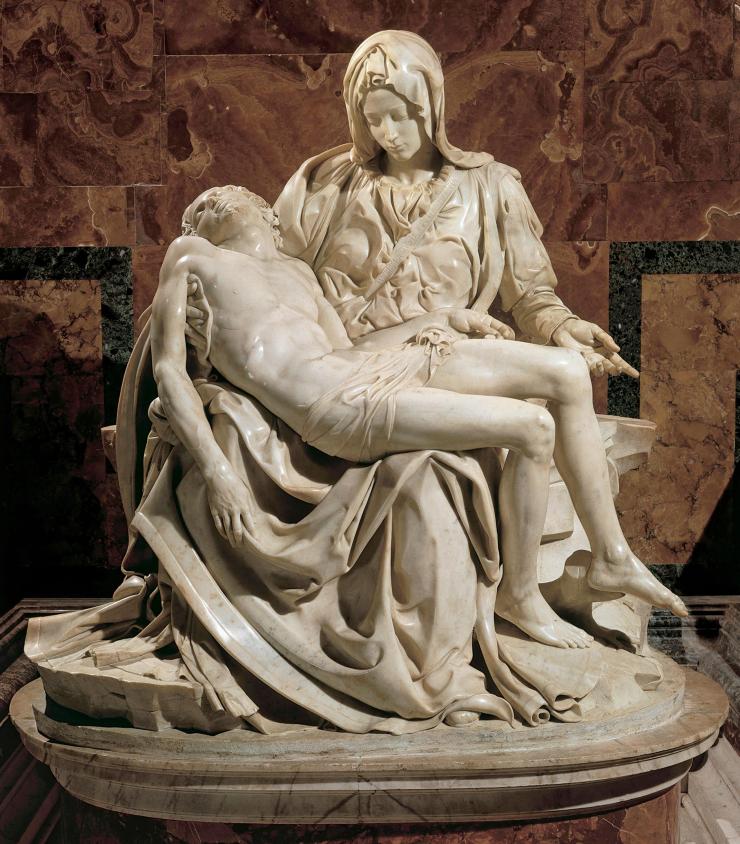
This is not an original insight of mine. Art critic Robert Hughes nailed Koons on this over a decade ago in this wonderful little interview [Koons portion starts at 2:56]:
If Hughes were still alive today, he wouldn’t be at all surprised or amused that Koons hadn’t learned anything new in a decade, and is just recycling his established techniques (such as the method he uses to have his assistants paint his paintings) in the name of the same old ideas around appropriation of mass culture.
With his new series, Koons takes the same idea and applies it to painting. There’s only one idea in there, and then a whole series of works created by the Koons’ factory. The blue balls reflect everything in the room, and by extension reflect everything in the art, in which case they are about everything. The viewers will see themselves in the mirrored balls, and thus become a part of the work, and Koons will then glibly attest that the works are incomplete without the viewer.
Really? If I were to go to a gallery or museum and see my own reflection in a ball, distorted and tinted blue, I wouldn’t consider that at all a meaningful engagement or involvement in art. And I have seen Koons’ works in person, including the highly reflective stainless steel Rabbit, and I didn’t get any more out of seeing my reflection in it than seeing myself reflected anywhere else.
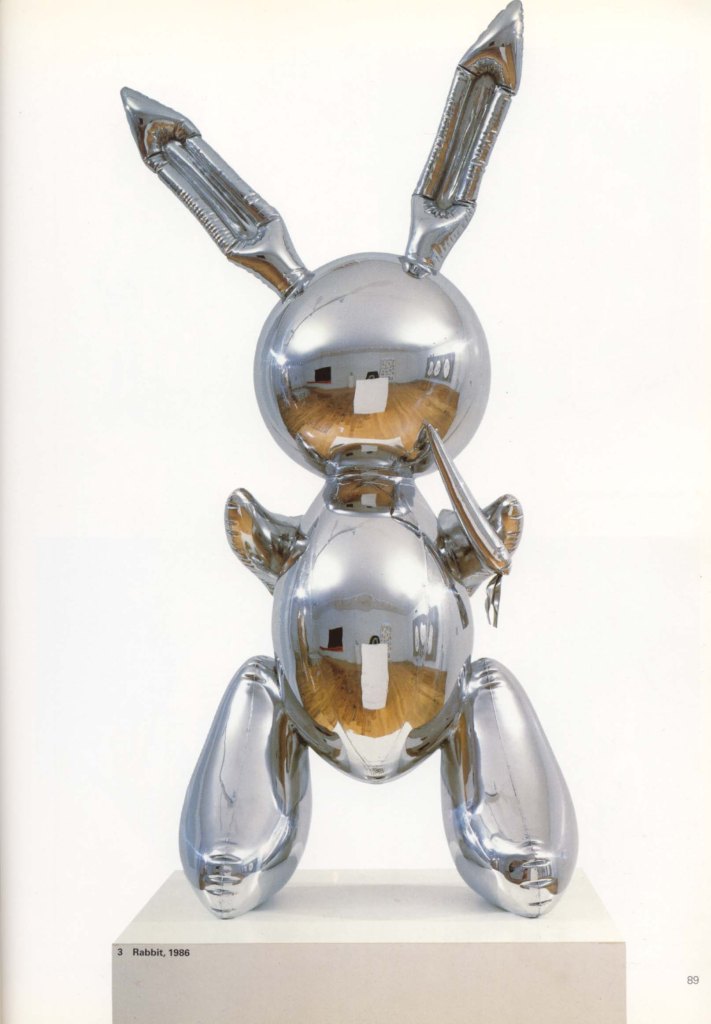
In reality the whole “see yourself in the art” rational is just an after-the-fact sleight of hand to convince a gullible public that Koons’ elitist spectacles, manufactured for the 1%, are really for everyone. Sometimes I’m not sure if Koons is stupid, or just thinks everyone else is stupid.
No, Jeff, when I see myself reflected in your nine-foot tall, 3,500 pound, stainless steel hanging heart which sold for $23,000,000 in 2007, I don’t feel warm or included.

Here’s what Jeff had to say about his hanging hearts:
I believe that the works are really about vindicating the viewer and, uh, uh, verifying their existence. I mean, uh, the piece needs THEM. Uh, if they move around, uh, the reflections change. It only exists, uh, through their being there… Uh, these works are about the viewer. Hopefully they find, um, some aspect of, of transcendence, uh, in the object… ~ Jeff Koons.
This work makes me feel alienated. There’s no emotion conjured by the piece, and nothing personal. It’s a giant Valentine’s day ornament, of, by, and for the ultra rich. It’s an insult. It’s hideously gaudy, and the most atrocious reminder that you need money not only to make money, but nowadays to even make art. I can’t get into baubles for billionaires. Nor can I afford to make them, or aspire to.

There are several things about this series that make it exemplary of the worst of contemporary art.
- It’s a gimmick.
- A whole series is made around one idea.
- The series is completed by a factory of workers.
- The work is made with the gallery space and buyers foremost in mind.
If you see yourself in one blue ball, what changes when you see yourself in the next one? Nothing. And that’s all Koons did was stick one blue ball in the middle of some famous paintings. The only thing that varies is the height at which the blue clown’s nose is superimposed on what was formerly a complete work of art, about which nothing could be changed without ruining it.
Clearly we are not supposed to just be looking at the blue balls like we went to the mall in the Christmas season on mescaline. [Fuck it. Jeff Koons is to art what marshmallows are to food. There. I said it. Looking at his work is like trying to chew like a caterpillar through a refrigerator-sized marshmallow.] We are intended to marvel at the paintings as if they are by Jeff Koons, somehow. Since his team of artists have functioned like a giant oil-paint printer, and made tedious paint-by-number copies of the old masterpieces, voila, we have painted objects to sell. Now, not only is Jeff Koons a sculptor on par with Michelangelo, he’s a painter of the same caliber as da Vinci.

I could provide more examples, but I think you get the idea. There’s a big-ass blue ball stuck to the front of famous paintings. And that’s it. The blue ball is Just Koons’ logo, or tag, and he thinks by tagging other people’s art he makes it his own, and can take credit for it, like Duchamp signing the urinal way back in the teens of the last century.
Please stop and appreciate this one idea. One of the chief goals, if not the chief goal of visual art is to exercise, explore, and showcase the visual imagination. That means exploring what you can do uniquely with visual language. You can imagine a musical analogy. Think of Hendrix or Charlie Parker if you like. Now notice that Koons never in his career exercises his visual imagination. You might be able to say he uses his imagination, no more or less than the art director of any mid-sized company, but not that he uses his visual imagination at all. He merely copies something that is already a part of our established visual repertoire, brands it, and recontextualizes it. He is like a musician who never strings together 3 original notes. Rather fascinating that the artists we most admire in the 20th century include those who never bother to use their visual imagination at all. Then notice that the artists Koons hopes to engulf like an amoeba DO use their visual imaginations in startling and original ways. Klimt and Seurat produced wildly original visions and explored imaginary realms that would not have existed without them. That Manet painting is visually profound. Yet everything Koons does already exists. His contribution is essentially branding it with his logo. Same with Hirst but he likes to rip off his contemporaries and prides himself of stealing and using money as his medium. For someone who wants to explore the visual imagination artists make visible, they offer absolutely nothing.
Obviously Koons ran out of ideas. I mean, I could improve on this whole series in about a second. Done. Instead of shiny blue balls, use donuts. Each painting gets a different, and somehow appropriate kind of donut on it. The donut can be porcelain, that’s fine. Now at least there’s something different about them and maybe something interesting or good to look at. Lemmie see what it would look like.
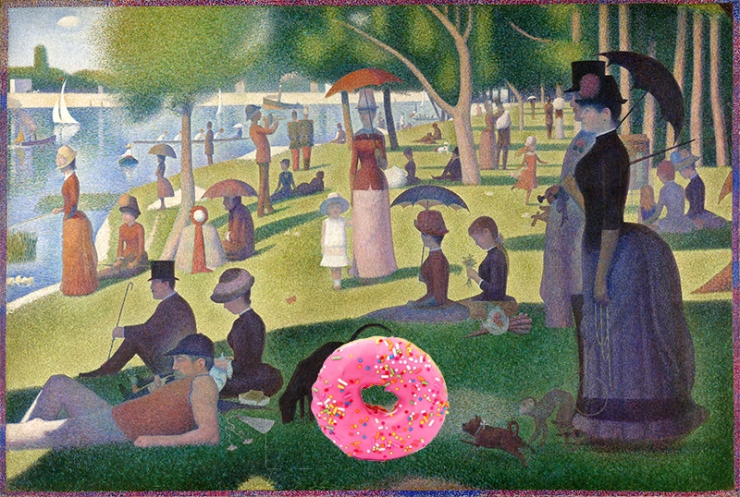
Get it? The Pointillist gets sprinkles! I did that as fast as I could, because, among other things I feel like writing about Koons is a waste of my time. Nevertheless, I’ve already improved his series (of course one would have to spend more time matching donuts with paintings, and not just doing the very first thing that came to mind). Know what else? Serve coffee and donuts. Sure, the same ones as are in the paintings. For free. In the gallery. At least it would be fun and an excuse to eat donuts (in a Fine Art context). Suuuure. Invite the cops in for free donuts. I know, I know, we’ve had some problems with overzealous cops lately, but, maybe this would mellow them out a bit and they’d feel more connected to the art world and everyone else. I guaran-fucking-tee more regular sorts of people (the 99%) would enjoy that than Koons’ blue balled baubles for oligarchs. He could show up and join us for donuts and coffee. No? Don’t be such a snob.
I don’t even know why Koons bothered to make this latest series, as it’s becoming more and more obvious that there’s really no substance to his art. Isn’t he rich enough already? Hasn’t anti-art already sidelined the visual imagination for rubber-stamped copies of infuriating kitsch and innocuous objects?
~ Ends
Addendum
Recently someone asked me something to the effect of what I would do instead. Well, since I’m an artist (as weird and pretentious as I feel writing that at this particular junction, for some reason), it’s really what I do instead. My art is based around the challenge of making new and meaningful original imagery. That’s the traditional challenge of visual art, and not one Koons partakes of. He comes from the Duchampian/Warholian tradition of denying originality or authenticity are possible (and not just quite difficult, and necessarily based on what others have done before), in which case they just borrow something from popular culture and put it in the museum context. To me that’s a bit like kicking over the chess board to win a game when you are in checkmate. Duchamp said new and meaningful imagery was impossible, and then Picasso painted Guernica, the whole Surrealist movement happened, and the Abstract Expressionists? Why do we still celebrate Duchamp?
So, yeah, I try to make new imagery that’s individual, as in only I could really do it with my particular skills, background, mind, and experience. I primarily work digitally (does anyone think da Vinci would be painting in oils if he were alive today?), but still have a traditional feel to my work most of which is done by using the drawing tablet. My work is personal and uses my imagination. It requires skills such as drawing anatomy, understanding lighting, arranging compositions, and balancing color, as well as knowing how to use computer programs, namely Photoshop, Blender, Painter, ArtRage, and Zbrush… I can’t have anyone else do it for me.
I don’t make any money. I am the anti-Koons.
Here’s my most recent piece, an 8 foot wide digital impasto painting using sci-fi (when painting died, who was painting cybors?) and focusing on the harsh reality of executions and excessive use of force that has plagued our species in recent years.

Here’s a detail showing my digital impasto technique (quite reminiscent of Bacon and Van Gogh):
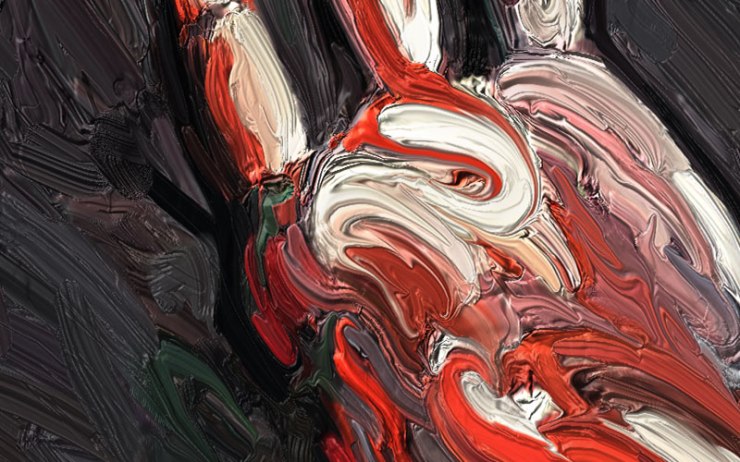 See much more about this piece here.
See much more about this piece here.
See all my new art here.
And if you like my art and art criticism, and would like to see me keep working, please consider making a very small donation. Through Patreon, you can give $1 (or more) per significant new work I produce, and cap it at a maximum of $1 a month. Ah, if only I could amass a few hundred dollars per month this way, I could focus entirely on my art. See how it works here.
Or go directly to my account.
Or you can make a small, one time donation to help me keep on making art and blogging (and restore my faith in humanity simultaneously).


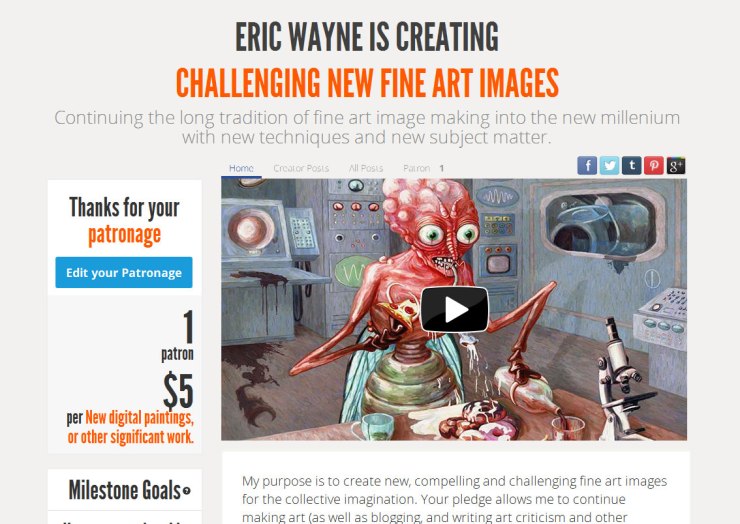

I assume that Yves Klein gets a royalty? 😉
LikeLiked by 1 person
Good ole Yves Klein! Just looked him up to see if you were talking about more than Yves Klein international blue, and I saw the classical sculptures he had painted blue, making them his own. They look as “contemporary” as Koons’ sculptures, but are from just before I was born. I may amend my article to include those. Thanks for pointing that out.
LikeLiked by 2 people
It’s amazing the difference a lick of paint can make.
LikeLike
Yeah, and you can just paint it another color, put sprinkles on it, or cover it with tar, and you’ve done the same thing again. I never really took Klein serioiusly (kind of a less shitty Piero Manzoni) , though I half-liked some of his stunts, which I generally considered all of his work to be. My biggest problem with him was I didn’t like his shade of blue. I like it more now, as my tastes in color have changed over the decades. But what I’m really interested in is those blue sculptures, which for me make Koons’ gaudy “gazing ball” sculpture of 2013 unnecessary, and prove once again that “radical” in the art world refers to a style, and not an actual progression, breakthrough, or imaginative leap. “Radical” has become a look, a kind of fashion, and not an unprecedented experimental leap at all. Think I’ll do a post comparing these two bodies of work separated by 50 years.
LikeLike
Yves Klein’s “classical sculptures” where his own work. Some are body cast he did from real people such the “Portrait relief PR3” of his poet friend Claude Pascal. Others after classical works like his “Venus de Milo” or “La Victoire de Samothraceare” are smaller copies that he sculpted (with alterations, edits) in plaster etc.
LikeLiked by 1 person
Footnote. Elucidation welcome, of course, but, as you might have surmised, I’m not that big on Yves Klein. Charming. But that’s about it as far as I’m concerned. My interest in visual art revolves around the visual imagination, not (vague) ideas about what art is or isn’t. Which is kind of like saying I prefer a great song to questioning whether someone just sitting on a piano stool and not playing a note is really music. That’s for a whole different level of pretentious wanker of a snob. I’m more in the guts of the imagination.
LikeLike
Well said, Sir!
Uhhg! Seems like such a scam to me. The emperor thinks that he’s da shit and no one is willing to tell him that his blue balls suck.
I can appreciate different art forms that I don’t particularly like, but this-to me-is not what I consider art.
LikeLiked by 1 person
Yea I couldn’t agree more. My whole experience at the Gagosian gallery was cold and lacked any emotional connection or even awe. I understand the reproductions are painted, even by his assistants, which doesn’t bother me. But the paintings are painted to look like a print however. There was hardly a trace of paint on the entire surface which was varnished. And that says a lot about technical mastery but very little about painting I think. He talks about his love for these paintings but I didn’t see any love in the show. Really unimpressed.
LikeLiked by 2 people
Thanks for commenting. Koons’ assistants use a standard sort of sophisticated version of paint by numbers to make Koons paintings. It’s an exacting but very dry process. I’m not sure if we can call it technical mastery, more than functioning as a human printer, hence the result that’s like a print.
Koons thinking seems transparent to me. Make a copy of something and put it in the gallery context thus transforming it to art. Do it which kitsch, or even advertisements. However, in order to give it value, have assistants reproduce it on a larger scale and with traditional artist’s materials. Thus a carefully reproduced advertisement becomes a priceless original painting by an art superstar. His more wacky paintings are computer collages, probably using Photoshop.
Koons is a bit of an enormously successful and lucky victim of a kind of simplistic thinking about art, in which some “radical” way of doing things, and a stray idea or two are seen as the ultimate aim of art, but were always rather extraneous parts of the process.
LikeLiked by 1 person
I enjoyed your post, actually really like your blog in general, and I agree with the points that you make. I also dislike Jeff Koons and I loathe this particular series. But the very fact that I have strong feelings about his art one way or another vindicates him in a way. Good art doesn’t just have to generate positive emotions.
I have to admire that he can make me discuss his work, even though I don’t see the artistic merit in it.
LikeLiked by 1 person
Yeah, it generates discussion. And that’s an accomplishment. Thing is, I think, better art generates better discussions. I have plenty to say about two of my favorite artists: Van Gogh, and Francis Bacon.
So, why just kill one bird with one stone, or maybe just maim it, when you can kill two. So to speak. I don’t like the bird getting hurt in the analogy. Let’s say free two birds with one hand.
And thanks for looking at my blog and commenting. Most appreciated.
LikeLiked by 1 person